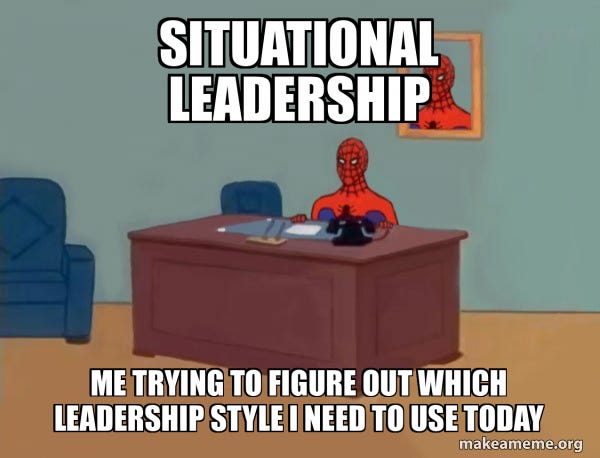Welcome to part two of searching for the best leadership style.
Refresh part 1:
Be spoiled with choices and choose which leadership style is yours.
Contents:
Situational Leadership – Adaptability Is Key
Transformational Leadership – Inspire and Motivate
Servant Leadership – Lead by Serving Others
Authentic Leadership – Be Real, Not Perfect
Transactional Leadership – Clear Structure & Rewards
Adaptive Leadership – Thriving in Change
Extreme Leadership – Take It All
Wrap Up
1. Situational Leadership – Adaptability Is Key
Are you also an ‘it depends’ kind of person?
The moment you consider what you should be doing, you are likely living in the realm of situational leadership.
Situational leadership emphasizes adaptability, and it was developed in the late 1960s by Paul Hersey and Ken Blanchard in their famous book Management of Organizational Behavior. What a classic!
As you would expect, the authors also had two approaches:
Situational Leadership® Model (Hersey) – focuses on task behavior and relationship behavior.
Situational Leadership® II (Blanchard) – refines the model by incorporating follower development levels and leadership styles.
Nothing is set in stone with situational leadership. Get ready to fall in love.
The model of situational leadership is built on earlier leadership theories. Especially:
Ohio Studies (40s-50s), which worked with task-oriented and relationship-oriented behaviors.
Blake & Mounton’s Managerial Grid (1964) with a focus on concern for people vs. concern for production.
Rensis Likert’s Leadership Continuum suggested that leadership effectiveness depends on how leaders adapt to their team’s needs.
Mix it all together, and voila. Hersey and Blanchard argued that no single style works best in all situations. Instead, leaders must adjust their behavior based on their followers' development levels.
The rationale is as follows:
People learn and develop at different rates
Different learning curves for different roles.
Differences between newcomers vs. experienced coworkers
No one-size-fits-all
You can’t always be directive or participative. It does not work.
Different situations need different approaches
Tasks and relationships
Some people need clear instructions, while others need motivation and encouragement
Employee engagement and performance
If a leader is too hands-off with a beginner, they may feel lost.
If a leader micromanages experts, they may feel frustrated.
No more rigidity. Hersey and Blanchard wanted something practical and adaptable.
So, here it is. What generations of leaders have been using ever since:
The Four Leadership Styles
Leaders adjust their approach based on the needs of their team members:Directing (S1) – High directive, low supportive (for beginners who need clear instructions).
Coaching (S2) – High directive, high supportive (for developing employees needing guidance and encouragement).
Supporting (S3) – Low directive, high supportive (for employees who are skilled but lack confidence or motivation).
Delegating (S4) – Low directive, low supportive (for highly competent and committed employees who need autonomy).
The Four Development Levels
Employees move through different stages of development, requiring different leadership styles:D1 (Enthusiastic Beginner) – High commitment, low competence.
D2 (Disillusioned Learner) – Some competence, low commitment.
D3 (Capable but Cautious Performer) – High competence, variable commitment.
D4 (Self-Reliant Achiever) – High competence, high commitment.
Application in Leadership
Situational Leadership is widely used in business, education, and coaching. It helps leaders:Adapt to individual team members' needs.
Work efficiently with their team.
Embrace flexibility.
Also read:
2. Transformational Leadership – Inspire and Motivate
Moving into the ‘70s with James MacGregor Burns, 1978 & Bernard Bass, 1985.
Transformational leaders inspire and motivate employees by engaging them in a shared vision.
It all looks too good to be true.
James MacGregor Burns wrote the book “Leadership” and distinguished between two leadership styles:
Transactional leadership (exchanges, aka leaders reward followers for performance, e.g., bonuses, promotions)
Transformational leadership (a value-driven leadership style where leaders inspire, challenge, and develop followers to achieve beyond expectations.
Building on Burns’ work, Bernard Bass (1985) further developed the concept by introducing the Transformational Leadership Model, which identified key behaviors that make transformational leaders effective.
Four key elements that define transformational leadership:
Idealized Influence (Role Model)
Leaders serve as role models, earning trust and respect.
They demonstrate strong ethics, integrity, and vision.
Followers admire and emulate their leader.
Inspirational Motivation (Vision & Purpose)
Leaders articulate a clear, compelling vision.
They create a sense of purpose and enthusiasm.
Employees feel inspired and energized to go beyond routine tasks.
Intellectual Stimulation (Encourage Innovation)
Leaders challenge assumptions and encourage creativity.
They foster a culture where new ideas and problem-solving are welcomed.
Employees develop critical thinking skills and take initiative.
Individualized Consideration (Coaching & Development)
Leaders provide personalized support to employees.
They act as mentors and coaches, helping employees grow.
Employees feel valued and understood, leading to higher engagement.
In theory, transformational leadership gives people a sense of being part of something bigger. They are proud of working towards it. They feel purpose.
Keep reading with a 7-day free trial
Subscribe to leadink to keep reading this post and get 7 days of free access to the full post archives.









